The Guitar Fingerboard With Triads
For the average guitar player, major and minor triads are the staple chords. Unless you branch out into classical or jazz, you will probably not run into augmented and diminished chords very often. You will see them used once in a while, or you may even use them in your own compositions, so it is important to understand these "other" triads enough to "deal" with them, but your main concern should be with major and minor.
That is the focus of this lesson. We will cover the diminished triad for the sake of including the Locrian mode in our discussion, but the augmented triad will be covered elsewhere.
When it comes to chords, most players know a couple of places on the neck where the chord can be played and leave it at that. The problem with this approach is that the creative possibilities of a single chord do not even begin to manifest until you can see the chord covering the entire fingerboard.
The first step to seeing anything covering the entire fingerboard is knowing where the notes lay well enough that you can see the root note in all possible locations.
For the sake of example, let's use an A major chord.
The first thing that needs to happen is that you look at your guitar neck and instantly see all the A notes:

The root note is the hook that you are going to hang the rest of the chord around. If you've done your homework on notes, you should have no problem spotting the A notes.
Next, you need to establish the third:

The third defines the tonality of the chord.
All that is left to do is establish the fifth:

If you understand the triads and inversions, you should recognize some old friends in this diagram.
Now, we're going to break this down into 7 interlocking chord shapes:
 |
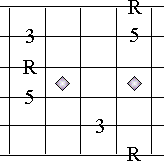 |
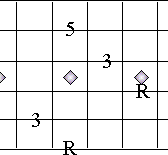 |
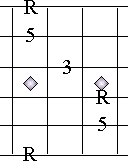 |
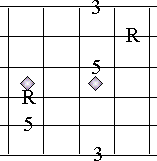 |
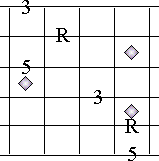 |
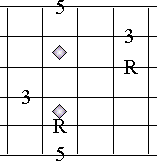 |
You need to be able to pick out common chard shapes and inversions within these 7 patterns. Otherwise all we have is a jumble of numbers on a bunch of lines. Don't forget that you can leave the fifth out of any inversion without sacrificing the tonality of the chord.
If you work with these 7 areas enough, you will realize that they are used in a lot of songs. When it comes to playing "cover" tunes, using the right inversion within the right area of the fingerboard can make the difference between almost sounding like the recording vs. nailing that sucker to the wall. If you write your own songs, adding different variations of common chords can inspire you to come up with something "new" instead of rehashing the same old progression over and over again.
Now that you know the formula, you need to work out the A minor triad and the A diminished triad. Then you need to know all three triads well enough that you can transpose the whole thing into every other key.